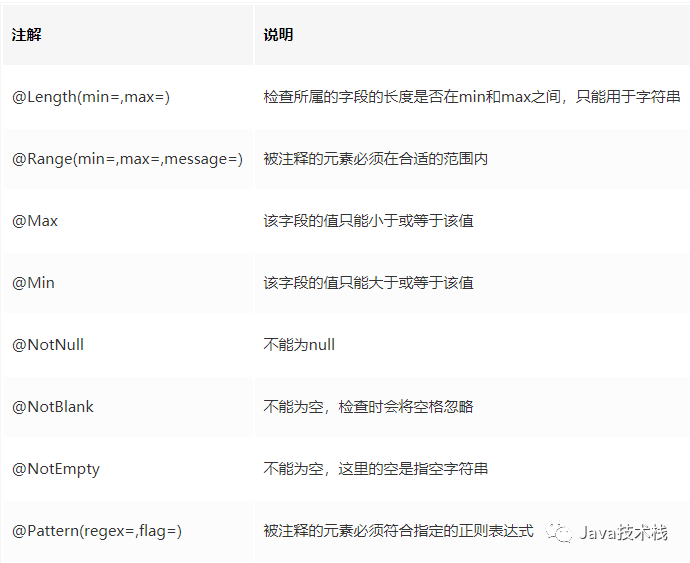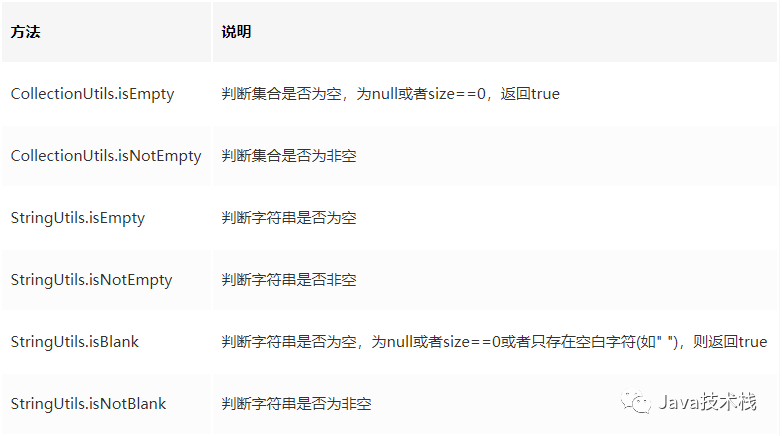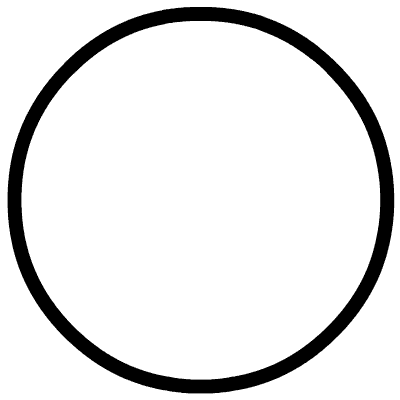Spring Boot 进行优雅的字段校验,写得太好了!
点击关注公众号,Java干货及时送达
作者:何甜甜在吗
来源:juejin.cn/post/6913735652806754311
前段时间提交代码审核,同事提了一个代码规范缺陷:参数校验应该放在controller层。到底应该如何做参数校验呢
Controller层 VS Service层
去网上查阅了一些资料,一般推荐与业务无关的放在Controller层中进行校验,而与业务有关的放在Service层中进行校验。
那么如何将参数校验写的优雅美观呢,如果都是if - else,就感觉代码写的很low,还好有轮子可以使用
常用校验工具类
使用Hibernate Validate
引入依赖
org.hibernate
hibernate-validator
4.3.1.Final
常用注解说明

使用姿势
Spring Boot 基础就不介绍了,推荐下这个实战教程:
https://github.com/javastacks/spring-boot-best-practice
需要搭配在Controller中搭配@Validated或@Valid注解一起使用,@Validated和@Valid注解区别不是很大,一般情况下任选一个即可,区别如下:

虽然@Validated比@Valid更加强大,在@Valid之上提供了分组功能和验证排序功能,不过在实际项目中一直没有用到过
Hibernate-validate框架中的注解是需要加在实体中一起使用的
public class DataSetSaveVO {
//唯一标识符为空
@NotBlank(message = "user uuid is empty")
//用户名称只能是字母和数字
@Pattern(regexp = "^[a-z0-9]+$", message = "user names can only be alphabetic and numeric")
@Length(max = 48, message = "user uuid length over 48 byte")
private String userUuid;
//数据集名称只能是字母和数字
@Pattern(regexp = "^[A-Za-z0-9]+$", message = "data set names can only be letters and Numbers")
//文件名称过长
@Length(max = 48, message = "file name too long")
//文件名称为空
@NotBlank(message = "file name is empty")
private String name;
//数据集描述最多为256字节
@Length(max = 256, message = "data set description length over 256 byte")
//数据集描述为空
@NotBlank(message = "data set description is null")
private String description;
}
@PostMapping
public ResponseVO createDataSet(@Valid @RequestBody DataSetSaveVO dataSetVO) {
return ResponseUtil.success(dataSetService.saveDataSet(dataSetVO));
}
说明:在校验的实体DataSetSaveVO旁边添加@Valid或@Validated注解。
使用commons-lang3
引入依赖
org.apache.commons
commons-lang3
3.4
常用方法说明

测试代码
//StringUtils.isEmpty
System.out.println(StringUtils.isEmpty("")); //true
System.out.println(StringUtils.isEmpty(" ")); //false
//StringUtils.isNotEmpty
System.out.println(StringUtils.isNotEmpty("")); //false
//StringUtils.isBlank
System.out.println(StringUtils.isBlank("")); //true
System.out.println(StringUtils.isBlank(" ")); //true
//StringUtils.isNotBlank
System.out.println(StringUtils.isNotBlank(" ")); //false
List emptyList = new ArrayList<>();
List nullList = null;
List notEmptyList = new ArrayList<>();
notEmptyList.add(1);
//CollectionUtils.isEmpty
System.out.println(CollectionUtils.isEmpty(emptyList)); //true
System.out.println(CollectionUtils.isEmpty(nullList)); //true
System.out.println(CollectionUtils.isEmpty(notEmptyList)); //false
//CollectionUtils.isNotEmpty
System.out.println(CollectionUtils.isNotEmpty(emptyList)); //false
System.out.println(CollectionUtils.isNotEmpty(nullList)); //false
System.out.println(CollectionUtils.isNotEmpty(notEmptyList)); //true
自定义注解
当上面的方面都无法满足校验的需求以后,可以考虑使用自定义注解。另外,关注公众号Java技术栈,在后台回复:面试,可以获取我整理的 Java、Spring 系列面试题和答案,非常齐全。







关注Java技术栈看更多干货

评论

